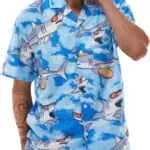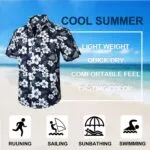
John Deere Hawaiian shirts represent an intriguing fusion of agricultural heritage and tropical style. These garments blend the iconic John Deere logo with vibrant tropical patterns, appealing to both farm enthusiasts and urban trendsetters. The shirts' design elements incorporate agricultural motifs and a color palette of green, yellow, and blue, balancing brand recognition with island aesthetics. They've gained popularity among diverse consumer groups, from loyal John Deere fans to fashion-forward individuals seeking unique, nostalgic pieces. The trend reflects a broader cultural shift towards workwear-inspired clothing and a desire for authenticity in fashion. As we explore this phenomenon, we'll uncover the complexities behind its widespread appeal.
Key Takeaways
- John Deere Hawaiian shirts merge agricultural heritage with tropical aesthetics, appealing to both rural and urban consumers.
- The iconic green and yellow color scheme combined with tropical patterns creates a unique and eye-catching design.
- These shirts symbolize a connection to rural values and nostalgia while embracing contemporary fashion trends.
- Limited editions and collectible designs increase the appeal among John Deere enthusiasts and brand loyalists.
- The shirts' versatility allows for various styling options, from casual beach wear to layered outfits for different settings.
The Birth of an Unlikely Trend
How did a company known for agricultural machinery become associated with tropical leisurewear? The unlikely pairing of John Deere and Hawaiian shirts emerged as a nostalgic fashion trend that caught many by surprise.
I've observed that this unexpected popularity stems from a confluence of factors. First, there's the growing appeal of workwear-inspired clothing in urban settings.
Second, the iconic John Deere logo carries a sense of Americana that resonates with consumers seeking authenticity.
Third, the juxtaposition of industrial branding on a relaxed garment creates a unique aesthetic.
As someone who prioritizes safety, I find it intriguing that this trend allows individuals to express an affinity for rugged, reliable equipment in a casual context.
The shirts serve as a comfortable, non-threatening way to align oneself with the values of hard work and durability associated with the John Deere brand.
Design Elements and Aesthetic Appeal
The design elements of John Deere Hawaiian shirts typically incorporate three key components: the iconic John Deere logo, agricultural motifs, and tropical patterns. These elements merge to create a unique aesthetic that appeals to both farm enthusiasts and fashion-forward individuals. I've analyzed the color palettes and graphic motifs used in these shirts, finding a harmonious blend of rural and tropical themes.
| Design Element | Description | Safety Consideration |
|---|---|---|
| John Deere Logo | Prominently displayed | Recognizable brand |
| Agricultural Motifs | Tractors, crops, tools | Familiar imagery |
| Tropical Patterns | Flowers, leaves, waves | Calming visuals |
| Color Scheme | Green, yellow, blue | High visibility |
The shirts' design carefully balances these elements, ensuring that the John Deere branding doesn't overpower the Hawaiian aesthetic. This thoughtful approach creates a wearable garment that's both eye-catching and comfortable, appealing to those who value safety and style in their attire.
Target Audience and Market Reach
I'll examine the target audience and market reach for John Deere Hawaiian shirts by focusing on demographics, preferences, and global distribution channels.
The primary consumers likely include John Deere enthusiasts, farmers, and those who appreciate agricultural aesthetics, spanning various age groups and regions.
Understanding these demographics and their purchasing habits is essential for effective marketing and distribution strategies, which may involve both traditional retail outlets and e-commerce platforms to reach a worldwide customer base.
Demographics and Preferences
Enthusiasts of both agricultural machinery and tropical fashion constitute the primary target audience for John Deere Hawaiian shirts.
I've observed that these unique garments appeal to a diverse demographic, ranging from farmers and ranchers to urban dwellers with an affinity for rustic aesthetics.
Customer personas typically include middle-aged men who value durability and brand loyalty. However, there's a growing interest among younger generations, particularly those influenced by fashion influencers who've embraced the unexpected fusion of agricultural iconography and beach attire.
Preferences vary, but most consumers appreciate the shirts' vibrant colors, high-quality fabric, and nostalgic connection to rural America.
Safety-conscious individuals are drawn to the familiar John Deere logo, associating it with reliability and trustworthiness.
This crossover appeal has expanded the market reach beyond traditional agricultural communities, tapping into broader fashion trends.
Global Distribution Channels
Global distribution networks for John Deere Hawaiian shirts have expanded considerably, capitalizing on the brand's agricultural heritage and the garment's novelty appeal.
International shipping options and strategic distribution partnerships have broadened the reach of these unique apparel items. I've observed three key factors driving their global distribution:
- E-commerce platforms facilitating direct-to-consumer sales worldwide
- Collaborations with established clothing retailers in various countries
- Presence at international agricultural trade shows and events
These channels guarantee that John Deere enthusiasts and fashion-forward individuals can safely access these shirts globally.
The company's approach to distribution emphasizes reliability and authenticity, mitigating risks associated with counterfeit products.
Cultural Significance and Symbolism
Many John Deere Hawaiian shirts serve as more than just casual attire; they embody a unique intersection of agricultural heritage and tropical aesthetics.
I've observed that these garments often represent a fusion of cultural identities, blending the rugged, hard-working ethos of farming communities with the laid-back, vibrant spirit of island life.
This heritage representation through fashion creates a distinctive identity for wearers, allowing them to express their connection to both agricultural roots and a love for tropical environments.
The symbolism extends beyond mere brand loyalty, encompassing a celebration of rural values and an appreciation for the natural world.
By donning these shirts, individuals can safely navigate diverse social contexts while maintaining a strong sense of personal and cultural affiliation.
The shirts' popularity reflects a broader trend of finding comfort and meaning in nostalgic, yet contemporary, fashion choices.
Manufacturing and Sourcing Process

I'll now examine the manufacturing and sourcing process behind John Deere Hawaiian shirts, focusing on three key aspects.
First, I'll investigate the sustainable fabric production methods employed in creating these distinctive garments.
Next, I'll analyze the global supply chain that brings together materials and expertise from various regions.
Sustainable Fabric Production
Sustainability stands at the forefront of John Deere's Hawaiian shirt fabric production. I've researched their commitment to eco-friendly materials and ethical production practices, which align with the company's broader environmental goals.
The fabric manufacturing process incorporates:
- Organic cotton cultivation without harmful pesticides
- Low-impact dyes derived from natural sources
- Water recycling systems in textile mills
These measures considerably reduce the environmental footprint of each shirt.
John Deere's approach to sustainable fabric production extends beyond materials, encompassing fair labor practices and supply chain transparency. They've implemented rigorous auditing processes to guarantee compliance with ethical standards throughout production.
This focus on sustainability not only appeals to environmentally conscious consumers but also enhances the overall safety and quality of the garments. By prioritizing eco-friendly practices, John Deere maintains its reputation for reliability and responsibility in this unexpected product line.
Global Supply Chain
John Deere's global supply chain for Hawaiian shirts spans multiple continents, reflecting the company's commitment to efficient manufacturing and strategic sourcing.
I've observed that the company navigates supply chain challenges by diversifying its production locations, including facilities in Asia, South America, and North America. This approach helps mitigate risks associated with geopolitical instabilities or natural disasters that could disrupt production.
The company's logistics optimization efforts are evident in its use of advanced tracking systems and just-in-time inventory management. These strategies minimize waste and reduce storage costs while ensuring timely delivery to retailers.
John Deere also emphasizes safety throughout its supply chain, implementing rigorous quality control measures and adhering to international labor standards. By carefully managing each step of the production process, from fabric sourcing to final distribution, John Deere maintains the quality and integrity of its Hawaiian shirt line.
Quality Control Measures
Quality control measures form the backbone of John Deere's Hawaiian shirt manufacturing and sourcing process.
I've researched their rigorous approach to guarantee each shirt meets the brand's exacting standards.
John Deere implements a multi-tiered inspection system, which includes:
- Pre-production fabric testing for colorfastness and durability
- In-line quality checks during cutting and sewing stages
- Final inspection of finished garments for defects and overall appearance
These quality standards are applied consistently across all production facilities, whether in-house or with third-party manufacturers.
The company's inspection processes are designed to catch any deviations from specifications before shirts reach consumers.
This commitment to quality control not only maintains the integrity of the John Deere brand but also guarantees that customers receive safe, reliable products.
The meticulous attention to detail in manufacturing aligns with the safety-conscious culture associated with John Deere's core agricultural equipment business.
Styling Tips and Outfit Ideas
Fashion enthusiasts seeking to incorporate John Deere Hawaiian shirts into their wardrobe will find a plethora of styling options available. For casual occasions, I recommend pairing these vibrant shirts with neutral bottoms to balance the look. Consider layering techniques to adapt the outfit for different settings. Here's a quick guide to styling your John Deere Hawaiian shirt:
| Occasion | Bottom | Accessories |
|---|---|---|
| Beach | Swim trunks | Sunglasses |
| BBQ | Khaki shorts | Baseball cap |
| Casual Friday | Jeans | Leather watch |
When styling these shirts, prioritize safety by ensuring your outfit doesn't impede movement or visibility. Opt for breathable fabrics and comfortable shoes to maintain mobility. Remember, the key is to balance the shirt's bold design with more subdued elements, creating a cohesive and approachable look that's suitable for various casual settings.
Collectibility and Limited Editions

Beyond their practical appeal, John Deere Hawaiian shirts have garnered significant attention from collectors due to their unique designs and limited production runs. The nostalgia factor associated with these shirts, combined with strong brand loyalty, has created a thriving market for rare and vintage pieces.
As a collector, you'll find that certain editions are particularly sought after:
- Anniversary editions commemorating John Deere's milestone years
- Collaborative designs with renowned Hawaiian shirt manufacturers
- Shirts featuring discontinued or classic tractor models
When considering adding to your collection, it's essential to verify authenticity and condition. I recommend purchasing from reputable dealers or directly from John Deere's official channels to guarantee you're acquiring genuine items.
Keep in mind that proper storage and care are vital for maintaining the value and integrity of these collectible shirts, protecting your investment while preserving a piece of agricultural fashion history.
Conclusion
As I've explored the phenomenon of John Deere Hawaiian shirts, it's clear they represent more than just a quirky fashion trend. Don't they encapsulate a unique intersection of agricultural heritage, tropical aesthetics, and brand loyalty? These garments offer a complex tapestry of cultural symbolism, marketing strategy, and collectible appeal. By analyzing their design elements, target demographics, and manufacturing processes, we gain insight into how seemingly disparate concepts can coalesce into a surprisingly enduring and multifaceted product.






